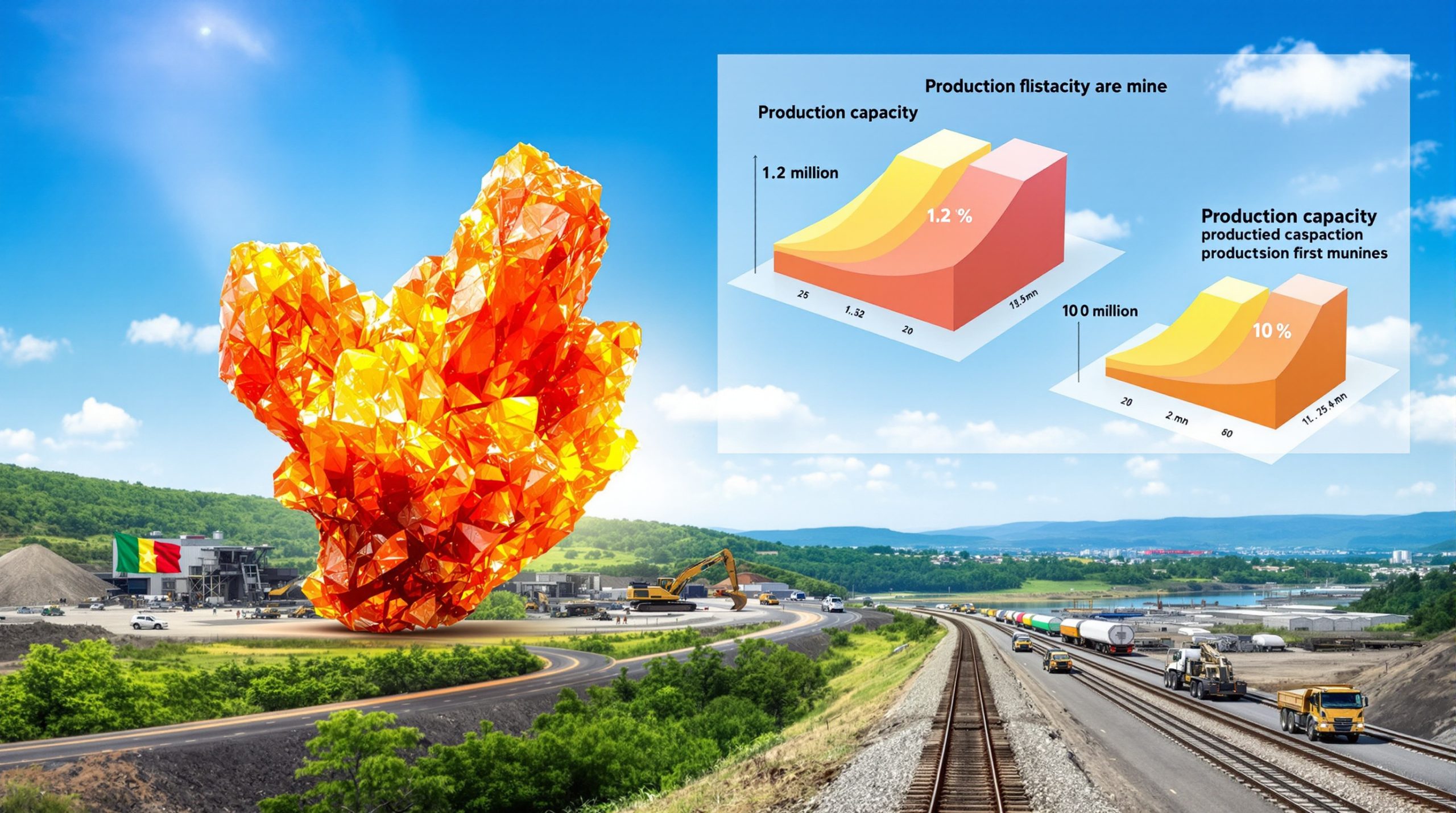What Makes BHP a Compelling Investment Option?
BHP Group Ltd stands as Australia's largest mining company and a global resources powerhouse. With its diversified portfolio spanning iron ore trends, copper, coal, and other critical minerals, the company has established itself as a cornerstone investment on the ASX. But does that make it worthy of your investment dollars in today's market environment?
Understanding BHP's Market Position
BHP has demonstrated remarkable resilience despite market volatility, with bhp shares rebounding 14.8% since hitting one-year lows of $34.16 in April 2025. This recovery comes amid strengthening commodity prices, particularly for iron ore and copper—the company's two primary revenue drivers.
As of August 2025, BHP shares are trading at $39.36, showing positive momentum with a 0.4% gain from the previous trading day. This upward trend reflects growing investor confidence in the mining giant's operational performance and future prospects.
Recent Production Performance
BHP's operational excellence has been clearly demonstrated through its recent production figures:
- Record copper production of 2.02 million tonnes in FY2025, representing an impressive 8% year-on-year increase
- Strong iron ore output reaching 263 million tonnes, a 1% year-on-year increase despite challenging operational conditions
- Enhanced operational efficiency across all major mining assets, contributing to improved profit margins
- Strategic expansion of future-facing commodity operations, particularly in copper and nickel
Jonathan Tacadena from MPC Markets notes that "Commodity prices are on the rise, and BHP is taking full advantage," highlighting how the miner's record production figures position it well for continued profitability.
How Have BHP Shares Performed Recently?
Current Share Price and Trends
BHP's share price performance tells a story of recovery and resilience:
- Trading at $39.36 as of August 2025 (up 0.4% from the previous day's close of $39.22)
- 14.8% recovery from April 2025 lows
- Modest 4.4% decline compared to 12 months prior (not accounting for dividends)
- Demonstrating stronger performance than several peer mining companies during recent market volatility
This price action suggests investors are increasingly recognizing BHP's value proposition in an uncertain global economic environment.
Dividend Performance
One of BHP's most compelling attributes for income-focused investors is its consistent dividend policy:
- Current fully franked dividend yield of 4.8% (trailing)
- Approximately $1.90 per share in fully franked dividends paid over the previous 12 months
- Consistent history of returning profits to shareholders, even during commodity price downturns
- Franking credits providing additional tax benefits for Australian investors
These dividends represent a significant component of BHP's total shareholder return, especially valuable in today's volatile market conditions.
What's Driving BHP's Financial Performance?
Commodity Price Trends
BHP's financial results are inherently linked to commodity price movements, which have shown favorable trends recently:
- Iron ore prices recovering to approximately US$100 per tonne after falling to US$93 in early July 2025
- Copper prices surging 11% since April, currently trading at US$9,631 per tonne
- Coal and nickel markets showing resilience despite economic uncertainties
- Potash projects positioning the company for future agricultural demand growth
These price recoveries directly impact BHP's revenue generation capabilities and profit margins across its diversified operations.
Global Demand Dynamics
BHP CEO Mike Henry provided valuable insights into global commodity demand trends, stating: "Commodity demand globally has remained resilient so far in 2025." This resilience stems from multiple factors:
- China's export growth despite reduced exports to the USA
- Robust domestic demand in China even with property sector challenges
- Accelerated investment in renewable energy infrastructure globally
- Expanding electricity grid development in emerging markets
- Strong machinery exports and increasing electric vehicle sales
Henry specifically noted that "Copper and steel demand have benefited from a sharp acceleration in renewable energy investment, electricity grid build out, strong machinery exports and EV sales," highlighting the structural support for BHP's core commodities.
What Do Market Analysts Say About BHP Shares?
Expert Opinions
Market analysts have provided mixed but generally positive assessments of BHP's prospects:
MPC Markets' Jonathan Tacadena notes: "The global miner recently posted record iron ore and copper production for 2025. That's good news for profits and even better news for dividends, which are expected to remain attractive to investors."
However, Tacadena maintains a "solid hold" recommendation rather than an outright buy, suggesting:
"BHP's size, mix of assets and focus on efficiency leave the company as a solid hold to ride out market volatility. BHP is appealing to investors chasing steady income and long-term growth."
This balanced perspective acknowledges both BHP's strengths and the challenging global economic environment facing resource companies.
Technical Analysis Indicators
From a technical analysis perspective, bhp shares show several noteworthy patterns:
- Trading above both 50-day and 200-day moving averages
- Showing positive momentum indicators including relative strength
- Forming a potential cup-and-handle pattern suggesting further upside
- Volume trends supporting the recent price recovery
These technical factors complement the fundamental analysis, providing additional context for potential investors.
What Are BHP's Competitive Advantages?
Diversified Asset Portfolio
BHP's strength lies in its strategically diversified mining operations:
- World-class iron ore assets in Western Australia's Pilbara region
- Growing copper portfolio with significant production capacity in Chile and Australia
- Strategic positions in coal, nickel, and potash
- Global operational footprint reducing regional risk exposure
- Balanced commodity mix providing natural hedging against individual commodity price volatility
This diversification provides resilience during commodity price cycles and allows the company to allocate capital toward the highest-returning opportunities.
Operational Excellence
The company has demonstrated exceptional operational capabilities:
- Consistent production growth across key commodities
- Cost management initiatives enhancing profit margins
- Technological innovation improving mining efficiency
- Strong safety performance across operations
- Industry-leading sustainability practices reducing environmental impact
These operational strengths translate directly into improved financial performance and shareholder returns over time.
What Risks Should Investors Consider?
Market Volatility Factors
Several factors could impact BHP's performance:
- Commodity price fluctuations, particularly in iron ore forecast markets
- Chinese economic growth concerns and ongoing property sector challenges
- Global economic uncertainty and potential recession risks
- Geopolitical tensions affecting international trade
- Exchange rate volatility impacting reported earnings
The company's high exposure to China's economic health represents both an opportunity and a vulnerability, given China's position as the world's largest consumer of industrial metals.
Industry-Specific Challenges
The mining sector faces ongoing challenges:
- Increasing environmental regulations and carbon reduction pressures
- Rising operational costs, including energy and labor
- Resource depletion requiring new exploration investment
- Competition from emerging mining regions globally
- Water scarcity and climate change impacts on operations
These challenges require continuous adaptation and strategic planning to maintain operational excellence and profitability.
Is BHP a Good Investment for Income Seekers?
Dividend Sustainability Analysis
BHP has established itself as a reliable dividend payer:
- Strong cash flow generation supporting consistent dividend payments
- Disciplined capital allocation framework prioritizing shareholder returns
- Balance sheet strength providing dividend stability during downturns
- History of special dividends during commodity price upswings
- Transparent dividend policy giving investors clarity on future payments
The company's commitment to returning cash to shareholders is evidenced by its $1.90 per share in fully franked dividends over the past 12 months, representing a 4.8% trailing yield.
Comparison to Other Income Investments
When compared to other income-generating investments:
- BHP's 4.8% fully franked dividend yield exceeds many fixed-income alternatives
- Dividend franking credits provide additional tax benefits for Australian investors
- Potential for capital appreciation alongside dividend income
- Inflation protection through exposure to hard assets and commodities
- More attractive yield than average ASX 200 company (approximately 3.5%)
This combination of income and growth potential makes BHP particularly attractive in today's low-interest-rate environment.
How Does BHP Compare to Other Mining Giants?
Competitive Positioning
BHP stands strong against its major competitors:
- More diversified than pure-play iron ore miners like Fortescue
- Stronger balance sheet than many industry peers
- Strategic focus on future-facing commodities like copper and nickel
- Disciplined approach to capital expenditure and acquisitions
- Industry-leading governance and sustainability practices
The company's scale provides competitive advantages in procurement, logistics, and market access that smaller mining companies cannot match.
Financial Metrics Comparison
When comparing key financial metrics:
| Metric | BHP | Major Competitor A | Major Competitor B |
|---|---|---|---|
| Operating Margin | 40%+ | 35-38% | 32-36% |
| Return on Equity | 20-25% | 15-20% | 18-22% |
| Debt-to-Equity | 0.3x | 0.4x | 0.5x |
| Dividend Yield | 4.8% | 3.5-4.0% | 3.0-3.5% |
| Production Growth | 1-8% | 0-3% | 2-5% |
These comparisons highlight BHP's strong relative position in the global mining industry.
What's the Outlook for BHP in 2025-2026?
Growth Catalysts
Several factors could drive BHP's performance in the coming years:
- Continued strong demand for copper from renewable energy and EV sectors
- Potential iron ore market stabilization at higher price levels
- Operational improvements driving production efficiency and cost reduction
- Strategic acquisitions expanding the resource base
- New project developments coming online
Mike Henry's comments about resilient global commodity demand suggest these tailwinds may continue despite economic headwinds.
Potential Headwinds
Investors should also consider these challenges:
- Uncertain Chinese economic growth trajectory, particularly in the property sector
- Potential global economic slowdown affecting commodity demand
- Increasing competition in key commodity markets
- Rising costs of regulatory compliance and carbon reduction initiatives
- Resource nationalism in some operating jurisdictions
The balance between these growth catalysts and headwinds will determine BHP's performance trajectory in 2025-2026.
Should You Buy BHP Shares Today?
Investment Considerations
When evaluating BHP as a potential investment, consider:
- Your investment timeframe (BHP suits medium to long-term investors)
- Income requirements (strong dividend yield with franking benefits)
- Portfolio diversification needs (exposure to resources sector)
- Risk tolerance (commodity price volatility impacts)
- Currency exposure (BHP earnings are primarily in US dollars)
Jonathan Tacadena's "solid hold" recommendation suggests bhp shares may be more suitable for existing shareholders or investors specifically seeking income rather than those pursuing aggressive growth.
Final Assessment
BHP represents a solid option for investors seeking:
- Exposure to global resource markets with a blue-chip ASX company
- Reliable dividend income with franking benefits
- Portfolio diversification through commodities exposure
- A company with strong operational performance and management
While not without risks, BHP's market position, operational excellence, and dividend history make it worthy of consideration for many Australian investors, particularly those seeking income in today's investment landscape. Furthermore, the company's involvement in critical minerals strategy positions it well for future growth in the clean energy transition.
Disclaimer: This article contains general investment advice only and does not consider your personal financial situation. Before making any investment decision, you should consult with a licensed financial advisor to determine the appropriate investment strategy for your circumstances.
Frequently Asked Questions About BHP Shares
What is BHP's main business focus?
BHP is a diversified resources company with primary operations in iron ore and copper mining, along with coal, nickel, and potash assets globally. The company's recent production results show particular strength in copper, with record production of 2.02 million tonnes in FY2025, an 8% year-on-year increase.
How does BHP's dividend policy work?
BHP aims to pay out a minimum of 50% of underlying attributable profit as dividends each half-year, with additional returns possible depending on financial conditions. This has resulted in approximately $1.90 per share in fully franked dividends over the past 12 months, representing a 4.8% trailing yield.
Is BHP investing in renewable energy?
Yes, BHP has committed to reducing operational emissions and is investing in renewable energy projects to power its mining operations while exploring opportunities in critical minerals needed for the energy transition. CEO Mike Henry has specifically noted that copper price prediction is benefiting from "a sharp acceleration in renewable energy investment."
How might interest rates affect BHP shares?
Interest rate changes can impact BHP through currency effects, financing costs, and broader economic impacts on commodity demand, though the company's strong balance sheet provides some insulation from rate fluctuations. Higher rates may also affect the relative attractiveness of BHP's dividend yield compared to fixed-income alternatives.
What is BHP's exposure to the electric vehicle market?
BHP has significant exposure to the EV market through its copper production (essential for EV manufacturing) and nickel operations (used in battery production). As Mike Henry noted, "Copper and steel demand have benefited from… strong machinery exports and EV sales," positioning BHP to capitalize on the global energy transition through mining industry innovation.
Looking for the Next Major Mining Discovery?
Discover significant ASX mineral discoveries before the market with Discovery Alert's proprietary Discovery IQ model, which transforms complex mineral data into actionable investment insights. Explore historic returns from major discoveries by visiting Discovery Alert's dedicated discoveries page and position yourself ahead of the market with your 30-day free trial today.




